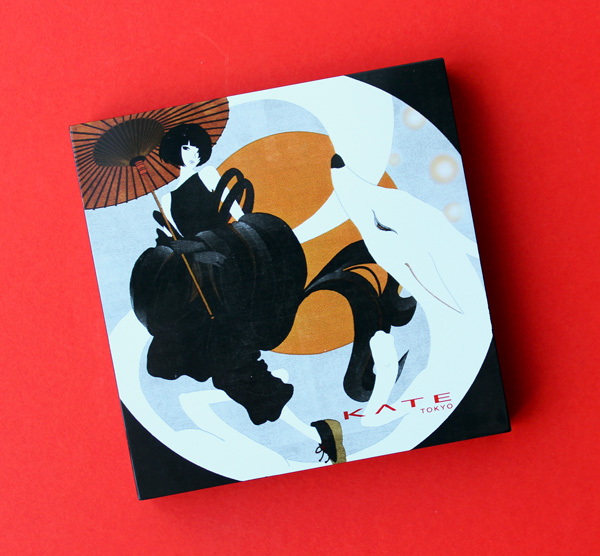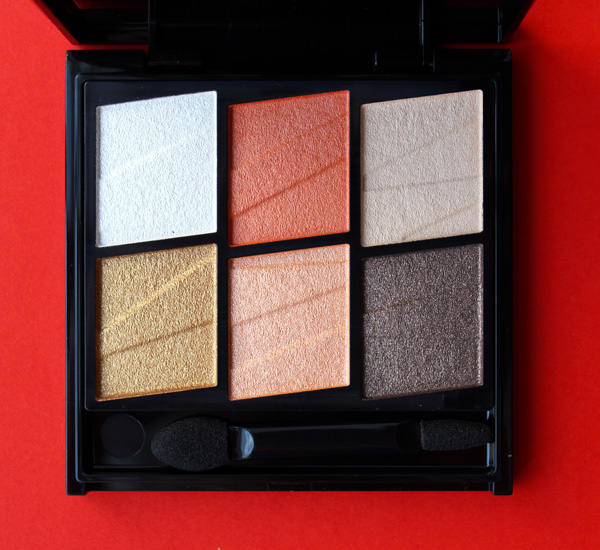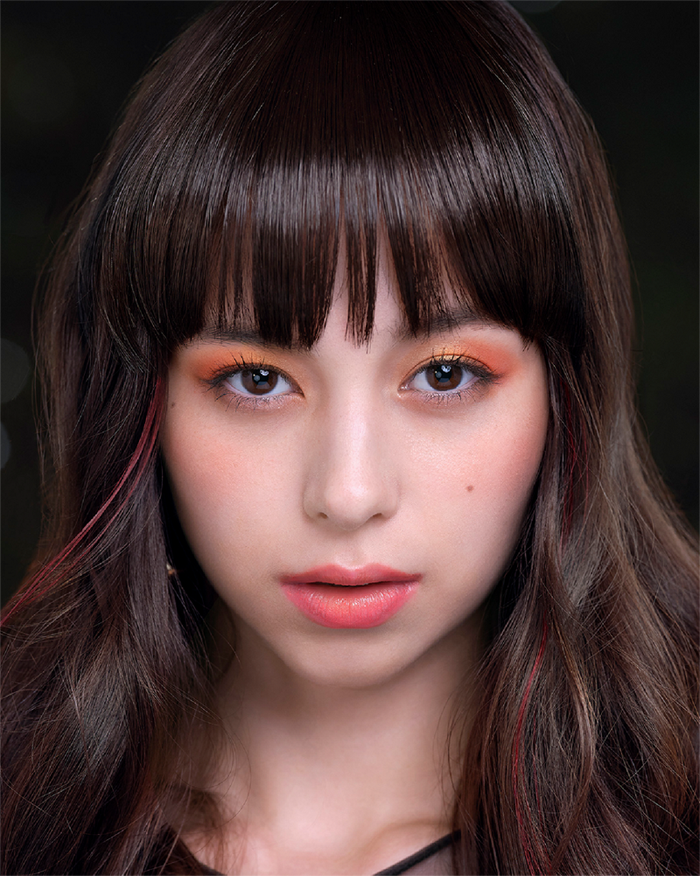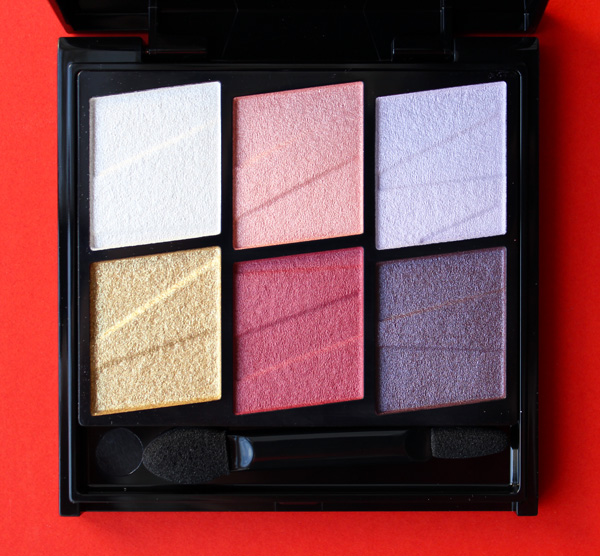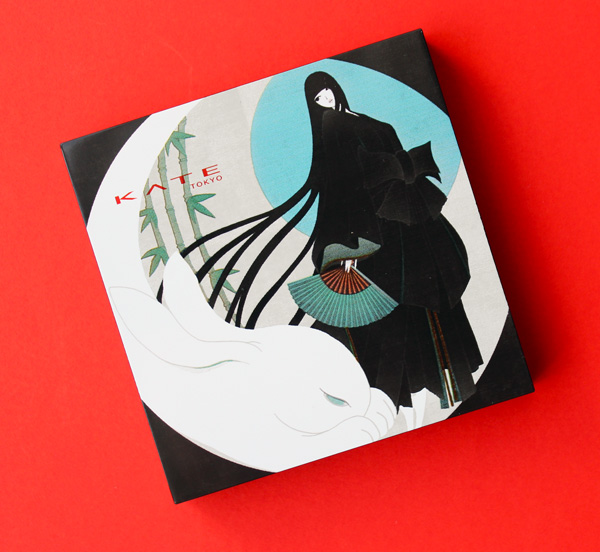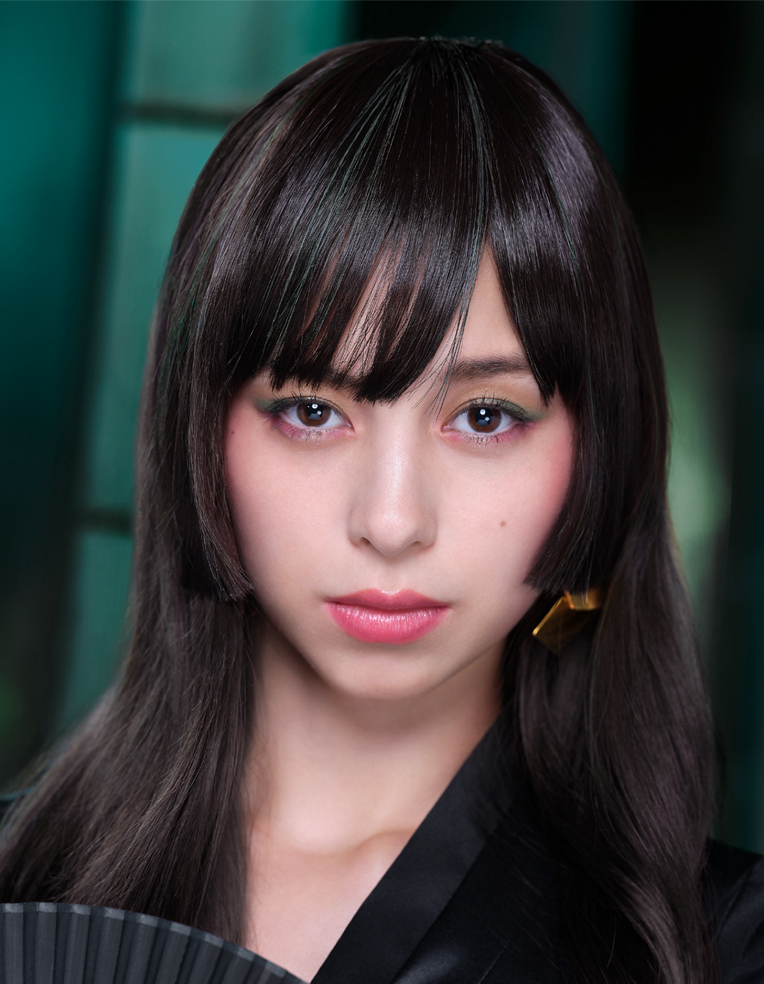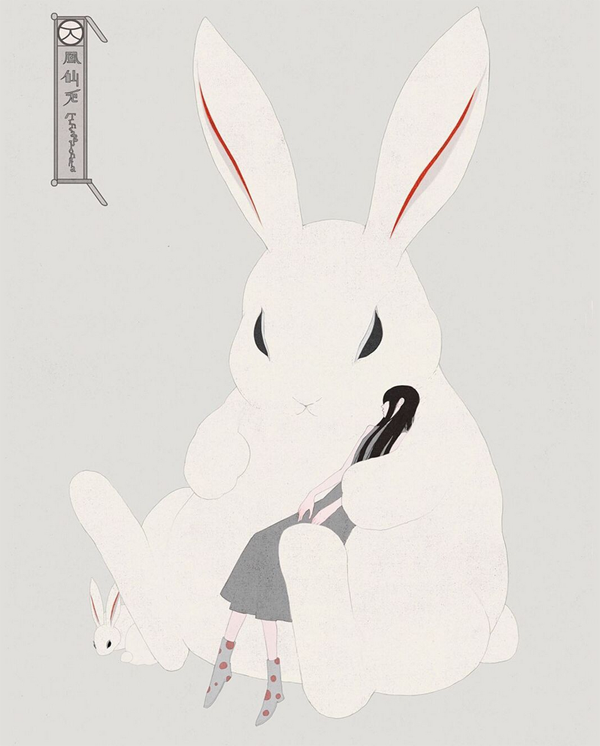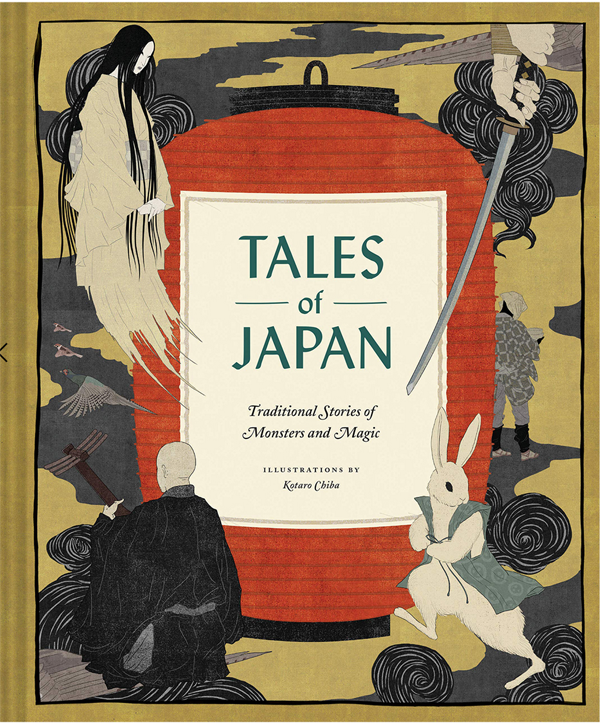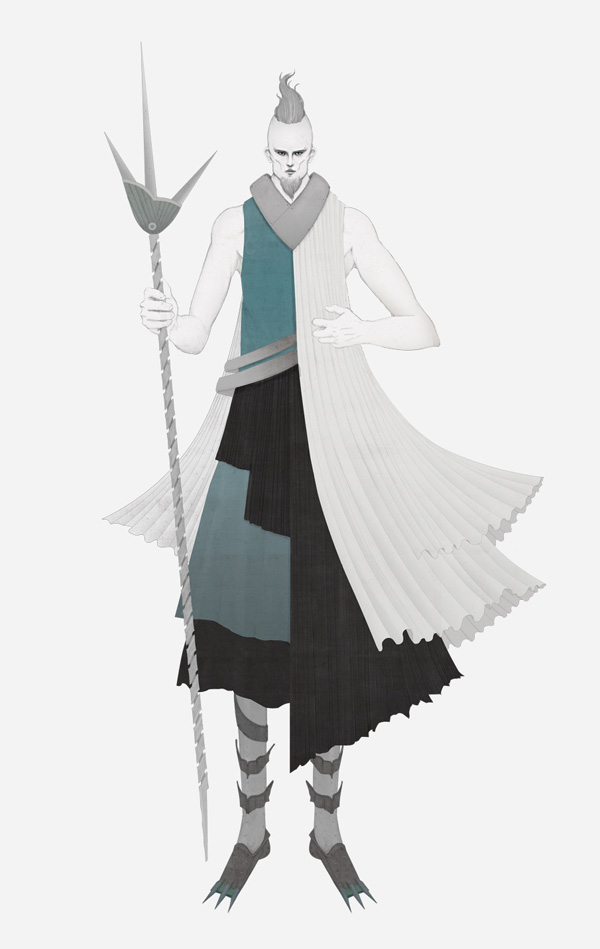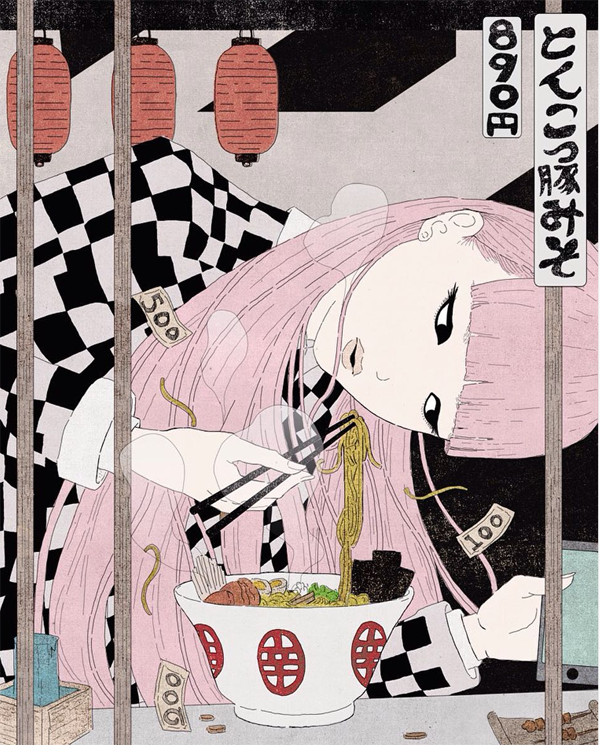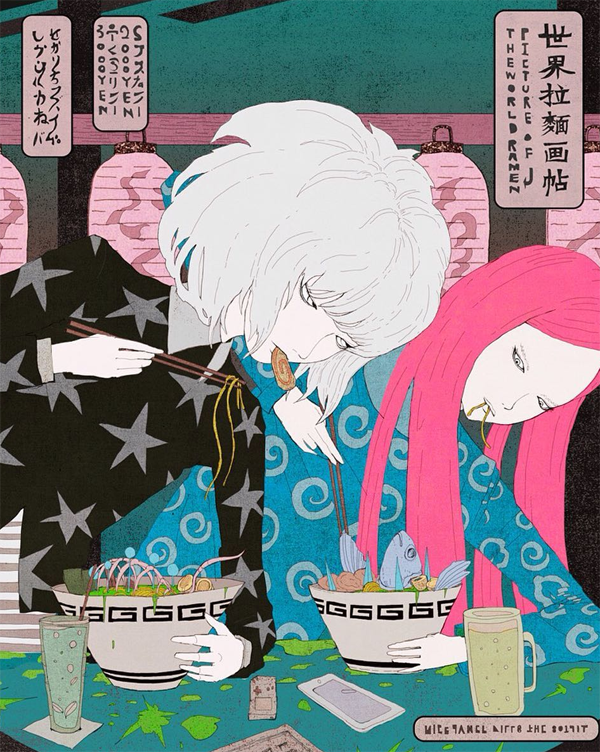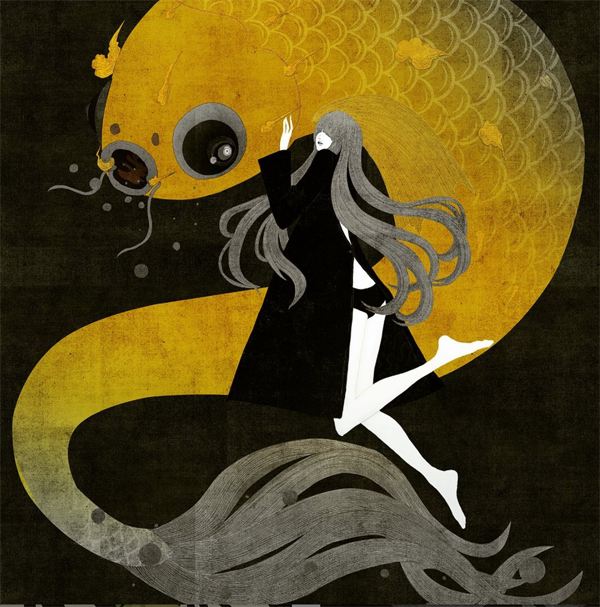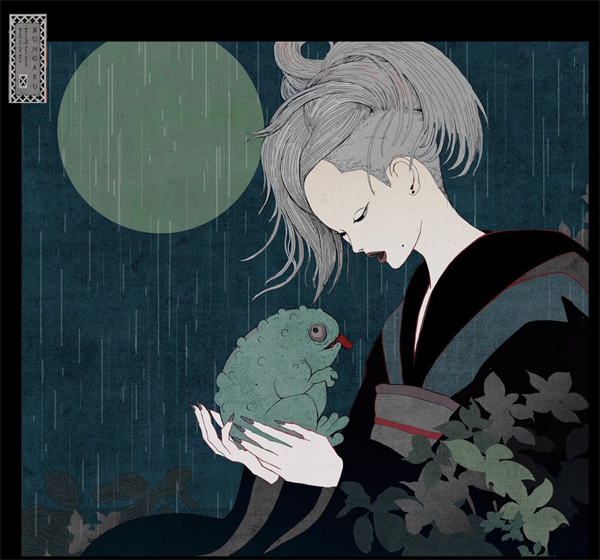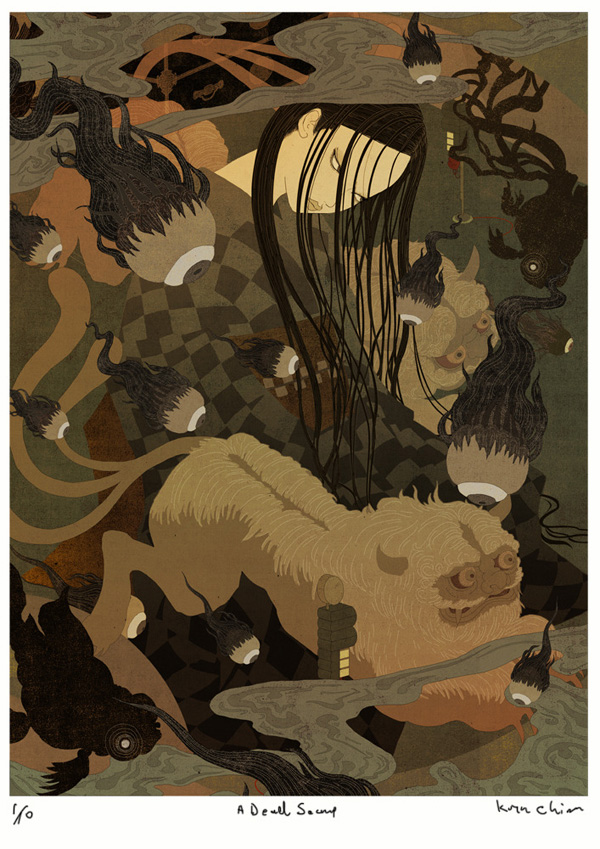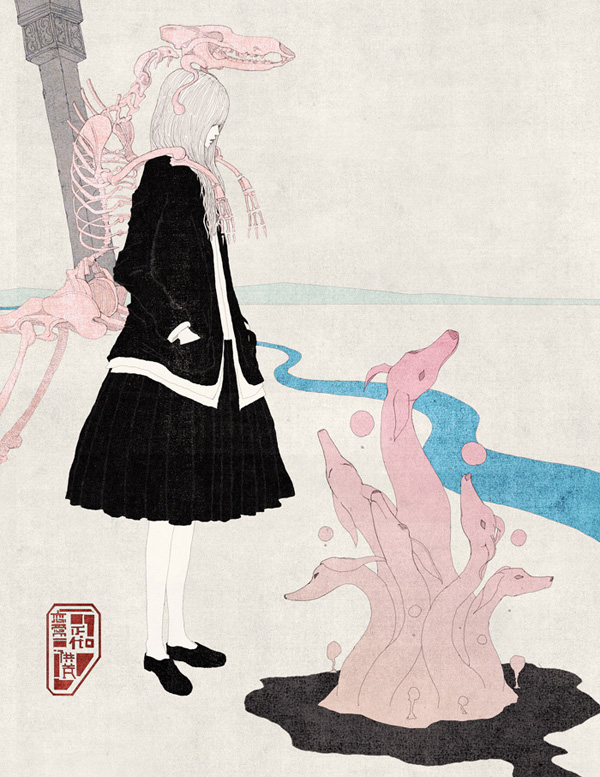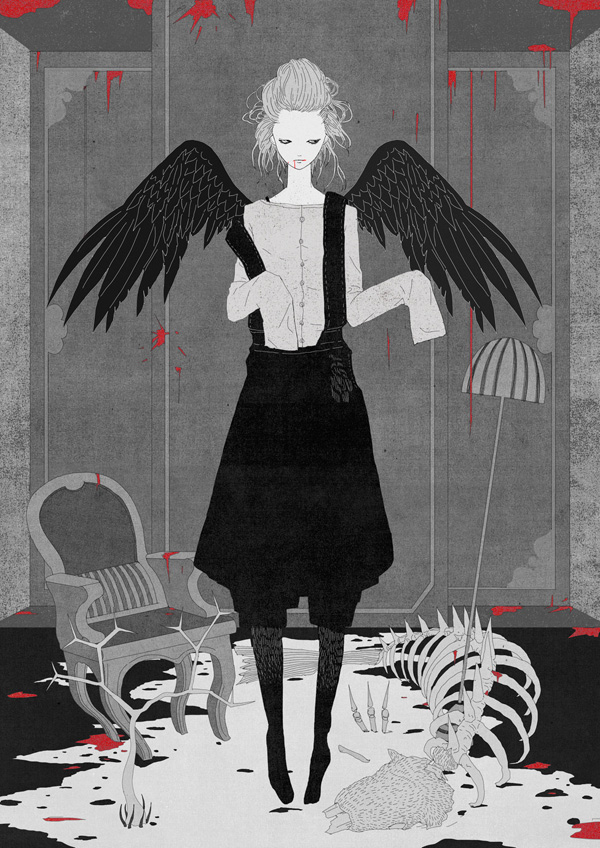As usual, there was no shortage of artist collabs of the holiday season. Kate is an affordably-priced Japanese brand owned by Kanebo, maker of the beautiful Milano compacts. I was immediately intrigued by the packaging for their holiday collection, and when I saw it was the result of a partnership with illustrator Kotaro Chiba, I knew I had to get my hands on it for the Museum. Entitled "Neo-Folklore: Reinterpretation of Japanese Folklore Heroines," Kate's holiday collection features modern reimaginings of the women in three Japanese folk tales who "face and shape their own destinies". There were lip gloss duos, eyeliners and eyeshadow palettes for each story. I just picked up the palettes since the designs were the same for all of the products.
The first story in the collection centers on Japan's vast array of fox-based fairy tales. Foxes, or kitsune, have a long-standing place in Japanese culture – there are entire books written on fox folklore – but the story Kate selected involves one version of the fox wedding, Kitsune no Yomeiri. As the traditional lore goes, foxes would create rain to keep humans away from the forest where they held wedding processions. But as foxes were also known to be shape-shifters, some lady foxes would change into human form and marry an unsuspecting man. Sometimes she'd be able to keep her true form a secret forever, but sometimes she would accidentally let her tail slip out. Once a family member sees that she's actually a fox she can no longer remain with them and must return to the forest (not sure why.)
The palette artwork depicts a woman clad in a black dress with swirls of voluminous fabric in the back (perhaps mimicking a tail?) and a fox curving around the edges. The golden white spheres on the right are most likely hoshi no tama, or star balls. These magical orbs are said to hold the fox's life force. If a human manages to get a hold of one they can control the fox.
The company created a makeup look and brief video to accompany each story. This one is called "Hint of a Wispy Flame," referencing the warm tones of a red fox and Inari shrines.
The video depicts a fox wedding which the bride apparently abandons. The "ghostly forest light" mentioned is known as kitsune-bi, magical fire produced by the foxes during wedding ceremonies and other processions. I'm still scratching my head over the ending…so she doesn't get married to a human but doesn't stay with her fellow foxes either? Where does she run off to?
The second story, known as Tsuru no Ongaeshi (Crane's Return of a Favor), or more specifically, Tsuru Nyobo (The Crane Wife) involves a man who helps an injured crane. I'll let Japan Folklore tell the tale, as it was the most straightforward version I found. "Long, long ago in a far off land there lived a young man. One day, while working on his farm, a brilliant white crane came swooping down and crashed to the ground at his feet. The man noticed an arrow pierced through one of its wings. Taking pity on the crane, he pulled out the arrow and cleaned the wound. Thanks to his care the bird was soon able to fly again. The young man sent the crane back to the sky, saying, 'Be careful to avoid hunters.' The crane circled three times over his head, let out a cry as if in thanks, and then flew away. As the day grew dark the young man made his way home. When he arrived, he was surprised by the sight of a beautiful woman whom he had never seen before standing at the doorway. 'Welcome home. I am your wife,' said the woman. The young man was surprised and said, 'I am very poor, and cannot support you.' The woman answered, pointing to a small sack, 'Don't worry, I have plenty of rice,' and began preparing dinner. The young man was puzzled, but the two began a happy life together. And the rice sack, mysteriously, remained full always. One day the wife asked the young man to build her a weaving room. When it was completed, she said, 'You must promise never to peek inside.' With that, she shut herself up in the room. The young man waited patiently for her to come out. Finally, after seven days, the sound of the loom stopped and his wife, who had become very thin, stepped out of the room holding the most beautiful cloth he had ever seen. 'Take this cloth to the marketplace and it will sell for a high price,' said the wife. The next day the young man brought it to town and, just as she said, it sold for many coins. Happy, he returned home. The wife then returned to the room and resumed weaving. Curiosity began to overtake the man, who wondered, 'How can she weave such beautiful cloth with no thread?' Soon he could stand it no longer and, desperate to know his wife's secret, peeked into the room. To his great shock, his wife was gone. Instead, a crane sat intently at the loom weaving a cloth, plucking out its own feathers for thread. The bird then noticed the young man peeking in and said, 'I am the crane that you saved. I wanted to repay you so I became your wife, but now that you have seen my true form I can stay here no longer.' Then, handing the man the finished cloth, it said, 'I leave you this to remember me by.' The crane then abruptly flew off into the sky and disappeared forever." There are some variations to the tale, such as the replacement of the man for an old couple who essentially adopt the young woman as their daughter, but the overall message remains the same: respect people's privacy.
The palette shows another woman in black holding a cat's cradle of yarn between her outstretched fingers. She appears to be watching the sliding door in the background. The head and neck of a red-crowned crane form a graceful arc over the scene.
The color story for this palette is also a nod to the red-crowned crane, according to the description at the Kate website.
As with the fox wedding story, I'm not really sure what the video is trying to say. At first the crane/woman is upset her trust was broken, but then seems okay with it?
The third story is the tale of Princess Kaguya, which dates all the way back to the 10th century. Move over Sailor Moon, there's another princess from our big round friend! Here's an abbreviated version from this website. "A long time ago, an old and humble man who was cutting bamboo saw that one of the logs he’d gathered was glittering in a strange way as if it was illuminated by the moon. Taking the log in his hands, he realized that inside was a beautiful and tiny little girl, about 7 centimeters tall. The man took her home because he’d never had children, and between him and his wife, they took care of her as if she were their own daughter…The strange girl grew into a beautiful woman of normal size, and over the years, people began to learn of the existence and beauty of this lady. Suitors traveled from all over to request her hand. On one occasion, five honorable gentlemen approached the house of the bamboo cutter trying to persuade him to allow his adopted daughter to marry. He was old and didn’t want to leave her alone upon dying, they argued. But she refused to take any husband, making impossible requests of her suitors in to avoid marrying them. The existence of the beautiful young woman came to the attention of the emperor, who requested that she appear in his court. When she refused, he visited her and, upon seeing her, he too fell madly in love with her. The emperor tried to take the girl to his palace to marry her, but the young woman assured him that if she were taken by force, she would become a shadow and then disappear forever. Each night, she watched the sky with melancholy. It was time to return to her place of origin, and it was then that she confessed to her adoptive father, in tears, that she had come from the moon and that her time on Earth was to end. Upon learning of this, the emperor sent guards to the house of the bamboo cutter, to try to prevent the princess from returning to her place of origin. One night, the moon was covered by a cloud. This quickly began to descend towards the Earth, while the sky grew ever darker. A carriage manned by luminous beings arrived for the princess. She left a letter and a small bottle with the Elixir of Life for the emperor before leaving. Frightened, he ordered that both be taken to the top of the most sacred mountain of that land and there, burned. To this day, it’s remembered that when there is smoke upon Mount Fuji, this is the letter and elixir that the Princess of the Moon left for the emperor, and these will continue to burn at the mountain’s peak."
Princess Kaguya is shown on the palette wearing a black kimono and standing in front of a stylized blue moon. Bamboo stalks in the background represent the princess's earthly beginnings, while the rabbit in the foreground is a reference to another lunar-themed tale, the moon rabbit (Tsuki no Usagi.)
I have to say none of the looks the company came up with seem particularly thoughtful or interesting. The collection allegedly centered on dismantling tradition and setting new narratives, yet the makeup seems rather safe and conventional. I understand Kate is a mass market brand, but something more daring couldn't have hurt.
Anyway, the video changes the ending of the tale, revealing that Princess Kaguya chooses to stay on earth.
Perhaps if I had any sort of grasp on the original tales and understood the videos I might have better insight of how these heroines were reinterpreted. At first I thought the Neo-Folklore collection was telling the same tales but emphasizing the independence of the women, portraying them as active agents of their own destinies rather than passive characters that things merely happen to. In the usual narratives, the crane/woman leaves her husband and the kitsune leaves her family so that they can fully express their true selves. Princess Kaguya, although sad to leave her parents, refused to accept a traditional married life and returned to her celestial home. But the videos the company made complicate these interpretations; the intent was to change the women's actions entirely. The kitsune abandons both her fox family and the prospect of marrying a human, the crane is proud to show her avian form when her secret is discovered, and Princess Kaguya chooses to stay on earth. I'm not sure the revised stories present any sort of significantly more "empowered" outcomes, but they at least attempt to depict these women as setting a wholly new course for themselves rather than adhering to the original story.
In any case, the artist Kate selected to highlight the women in these tales is a perfect fit. Kotaro Chiba is a self-taught artist based in Niigata, a relatively quiet, snowy city in northwest Japan. His father, a convenience store owner turned Buddhist monk, and mother, a piano teacher, were of modest means but instilled a love of art and culture in their son. "My family was poor in money but rich in culture. The little house where we used to live was full of art, music and literature. I started to study seriously the art myself when I worked part-time after my graduation from high-school. Of course, I would have liked to attend an art school, but I wasn't able to make it for financial reasons," he says. Chiba began his career around 2007 making t-shirt designs. He found he wasn't inspired by one particular style or theme, but a combination of manga, modern Western fashion and traditional Japanese style. While his work continues to evolve, the end result is surreal, fanciful and at times unsettling.
Chiba's experience illustrating a book of Japanese fairy tales in 2019 more than qualifies him to take on the Neo-Folklore collection.
His work sometimes takes on a more video-game, sci-fi fantasy vibe while still incorporating elements of traditional Japanese costume, such as this warrior character he created for an app.
Chiba is also adept at modern fashion illustration, particularly for women's dress. "I am not a fashion-addict or a fashionista and I don't have any good sense of trends, but I'm fascinated by fashion design. I just love it. I like the fact that fashion is sexual but doesn't express sexuality directly. I want to mix pop culture and classical sense," he says. Examples of this combination include his portraits of women consuming ramen, some with a decidedly modern appearance and one with a slightly more traditional Japanese style. While you'd never mistake them for antique wood-block prints, their flatness and composition reference the centuries-old art.
Chiba notes that as a self-taught artist, he had no one to help guide his style, so it evolves organically with little input from other artists. "I am self-educated, have no teacher or boss, so no one corrects what I do. My style is not static," he says. And he's right – in looking at his Instagram, it's hard to believe it's the same artist. But some of his pieces seem to be influenced by others. The lines on the woman's hair and the fish's tail in Kuro (2019), for example, are particularly reminiscent of Hiroshi Tanabe's work.
And I'm getting a Patrick Nagel feel from Ame (2020). You might recall Nagel was partially inspired by Japanese wood-block prints.
Despite being born and raised in Japan, Chiba says that manga and anime styles don't figure prominently in his oeuvre. I'm inclined to agree. As he states, the surrealist nature of some manga is present in his work, but not so much the aesthetic. "Manga is certainly different from western culture, as it doesn't fit in a logical world. It may represent a kind of surrealism. I carefully watched Dragon Ball Z on TV when I was a child, but in reality, I don't know much about manga. My foreign friends know better than me. Nevertheless, I can't deny the influence of Manga-anime."
Chiba's preference for illustrating women is another reason Kate made the right choice for a makeup collaboration focused on reinventing women's roles within fairy tales. The artist explains, "I prefer to draw female things. In fact, I'm more interested by gender than by womanhood and sexuality. I hate masculinity because it's too simple…My illustrations are often said to be 'too feminine', even when I draw male characters." For the most part, Chiba's female characters are depicted as independent, powerful and sometimes even fearsome. A girl wearing an animal skeleton while nonchalantly observing a six-headed dog growing out of the ground, for example, is not someone to be trifled with.
Nor is a strange bird-vampire levitating in a blood-spattered room above the carcass of the animal she has presumably exsanguinated.
The illustration he created for a cover of a novel earlier this year is similar to those for the Kate collection, with the cat's form cradling the central character in the same way the fox, crane and rabbit – also rendered in white – curve around on the palettes. The skull held by the woman, the cat's skeletal tail, and the floating sperm-like shapes point to a story about life and death, perhaps?
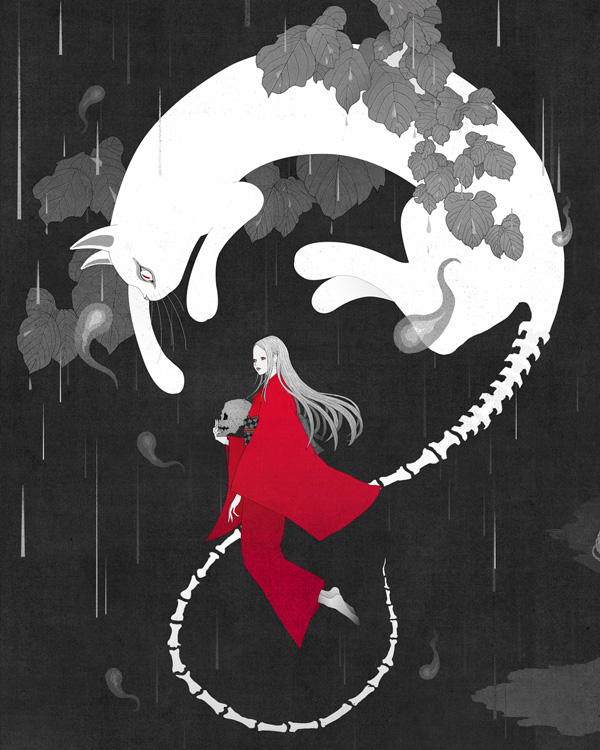
(images from kate.global.net, @kotaro_chiba, and kotarochiba.portfoliobox.net); artist quotes from interviews at kyoorius.com and hiwo.tv)
I wish I knew more about Chiba's inspiration for the Neo-Folklore collection and how the collab came about, but my request for an interview went unanswered. Ah well, it's the holidays. But he did shed light on his process during one interview, noting that he creates straight from memories or visions he has in his head, rather than directly referencing a photo. "I like to design all objects in the picture by myself: outfit, furniture, landscape, etc…that is the feature of my works. I don't like to draw something from reference photos (though I'm sometimes obliged to because I'm running out of time). The idea of the design usually only exists in my brain." In the case of the Neo-Folklore collection, it seems that he simply translated his familiarity with these fairy tales growing up and the particular characters and objects associated with them (animals, yarn, bamboo, etc.) to his own style. If it were me, of course, I'd read every version of the fairy tale and look at every illustration before trying to come up with something of my own, but that's why I'm not an artist. ;) Nevertheless, I see some similarities between us. He likes living in a smaller city and set out to do something creative, even though he lacked formal training, just because he thought he would enjoy it. And maybe it's because Chiba is self-taught, but he seems quite unpretentious and relaxed compared to some artists I've come across. "I didn't want to specifically to be an illustrator. I wanted to create something. I knew that this would make me happy…I love that quiet atmosphere [of Niigata]. My favorite place is the Starbucks in the neighborhood! If I had to move elsewhere, I'd chose the countryside. My daily routine is to buy a coffee at the convenience store nearby. I think a good sleep brings better productivity. I don't go to bed late because I want to reduce stress as much as possible. It took a long-time to have self-confidence. I still have just a little confidence, not enough to fight with the world."
What do you think of Chiba's work? And which story is your favorite? They were all kind of sad to me, even the revamped versions, but I love the idea of foxy lady shapeshifters since they remind me of some mermaid stories where they can switch between mermaid and human form.



